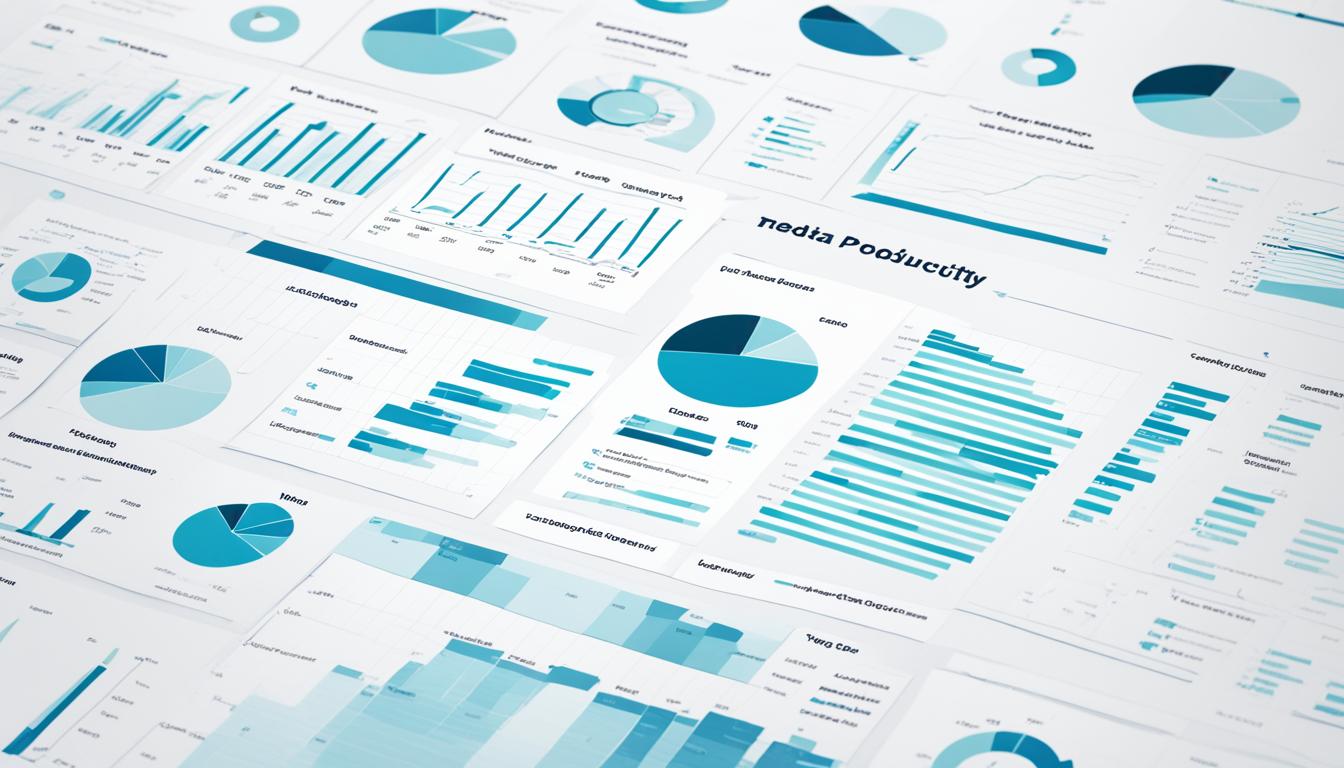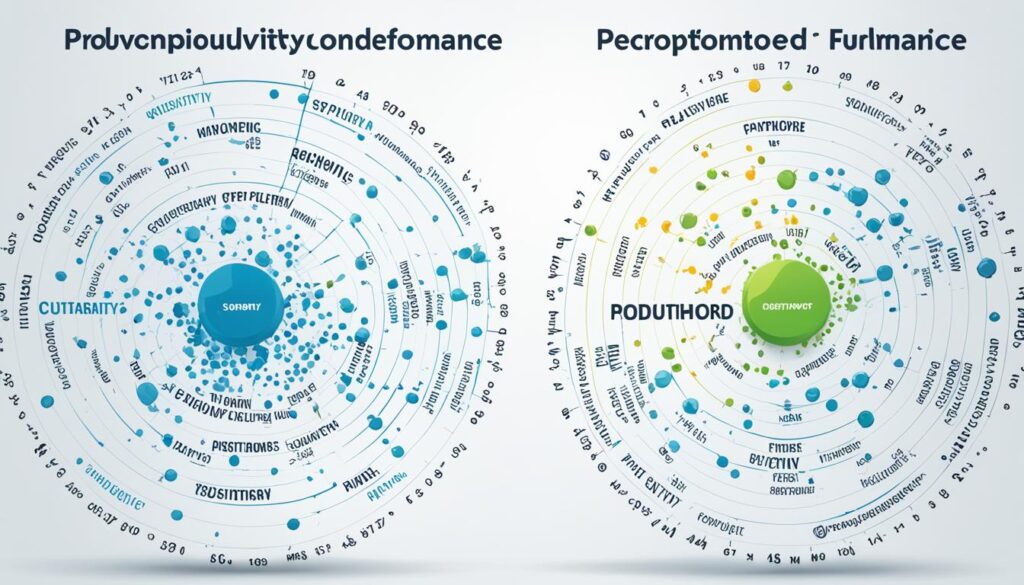Boost Your Success with Key Productivity Metrics

Do you want to unlock the secrets to maximum efficiency and performance in your business? Are you tired of relying on guesswork and intuition to evaluate your workforce productivity? What if I told you there is a proven method to measure efficiency and drive data-driven decision-making? Introducing productivity metrics – the game-changer that will revolutionize the way you assess and optimize your business operations.
Productivity metrics are not just numbers. They provide valuable insights into the effectiveness of your output, helping you identify areas for improvement and make informed decisions. By tracking productivity through key performance indicators (KPIs) and performance analytics, you can gain a deep understanding of your workforce productivity and take targeted actions to enhance performance.
But how do you measure productivity effectively? What are the best practices to set your KPIs and ensure they align with your business goals? And what are some examples of productivity metrics that you can start using today?
In this article, we will dive into the world of productivity metrics, exploring their significance, measurement techniques, and real-life examples. We will show you how to leverage productivity metrics to increase your business results, optimize your operations, and achieve sustainable success.
Key Takeaways:
- Productivity metrics are essential tools for evaluating and improving workforce performance.
- By measuring efficiency through data-driven insights, businesses can make informed decisions and drive success.
- It’s crucial to select the right productivity metrics that align with your specific goals and business context.
- Leading and lagging indicators should be used together to get a comprehensive view of productivity.
- Examples of productivity metrics include overtime hours, overall labor effectiveness, and revenue per employee.
What Are Productivity Metrics?
Productivity metrics are essential tools that help businesses measure the effectiveness of their output and identify areas for improvement. These measurements, often referred to as productivity Key Performance Indicators (KPIs), offer valuable insights into the performance of employees and the utilization of resources.
Productivity metrics go beyond simple quantitative measurements and take into account various factors such as time management, the quality of work, and collaboration. By assessing these metrics, businesses can gain a comprehensive understanding of their overall productivity and identify areas that require attention and optimization.
Importance of Productivity Metrics
Measuring productivity through data-driven KPIs provides businesses with accurate and objective information to make informed decisions and optimize performance. By tracking productivity metrics, organizations can:
- Identify and address areas for improvement
- Optimize resource allocation
- Enhance time management
- Improve collaboration and teamwork
Furthermore, productivity metrics enable businesses to assess their current productivity levels and set realistic goals for continuous improvement. These metrics serve as a guide to ensure maximum efficiency and effectiveness in achieving desired outcomes.
Defining Productivity Metrics for Your Business
Before implementing productivity metrics, it’s crucial to define what productivity means for your specific business. Each organization has unique goals and priorities, and thus, the selection of productivity KPIs should align with these objectives.
When selecting productivity metrics, it’s important to strike a balance between measuring critical areas for improvement and avoiding an overwhelming focus on too many metrics. By limiting the selection of KPIs, businesses can allocate their resources more effectively and effectively assess their performance.

Examples of Productivity Metrics
Productivity metrics can vary depending on the specific industry and department within an organization. Here are some examples of productivity metrics that can be utilized to assess employee productivity:
| Productivity Metric | Description |
|---|---|
| Overtime Hours | Measures the additional hours worked beyond regular working hours, indicating individual employee output and cost. |
| Overall Labor Effectiveness | Evaluates the efficiency of the entire workforce, considering factors such as utilization, availability, and performance. |
| Revenue per Employee | Assesses the productivity and profitability of the business by measuring the revenue generated per employee. |
| Planned-to-Done Ratio | Measures the completion rate of assigned tasks, highlighting areas for productivity improvement. |
These are just a few examples of productivity metrics that can be utilized to measure and improve productivity in different departments and industries.
How To Measure Productivity? Best Practices to Set Your KPIs
Measuring productivity is crucial for businesses to track progress and make data-driven decisions. By implementing effective productivity metrics, you can gain valuable insights into the efficiency and effectiveness of your workforce. To ensure accurate measurements and align your metrics with your business goals, it is important to follow these best practices:
1. Define Productivity for Your Business
Before setting productivity metrics, take the time to define what productivity means for your specific business. Consider the activities and outcomes that directly contribute to achieving your business goals. This will help you determine which metrics are most relevant and meaningful for your organization.
2. Choose Metrics That Align with Your Goals
Select productivity metrics that align with the specific goals of your business. Look for metrics that provide insight into the areas you want to improve or track closely. For example, if increasing labor productivity is a priority, you might choose metrics that measure the output per hour or per employee.
3. Consider Leading and Lagging Indicators
To get a comprehensive view of productivity, it is important to consider both leading and lagging indicators. Leading indicators provide insights into future performance trends, allowing you to proactively identify areas for improvement. Lagging indicators measure historical performance and can help you assess the effectiveness of previous actions or initiatives.
4. Ensure Attainable and Actionable KPIs
Set Key Performance Indicators (KPIs) that are realistic and attainable for your business. Avoid setting overly ambitious targets that may demotivate employees or create unnecessary pressure. Additionally, ensure your KPIs are actionable, meaning they can directly influence behaviors or processes that contribute to productivity improvement.
5. Gather Relevant Data
To measure productivity accurately, it is essential to gather the necessary data. Implement systems and tools that can help you collect relevant data points, such as employee output, time spent on tasks, or project completion rates. Regularly track and update this data to monitor progress and identify areas for improvement.
6. Leverage Online Data Analysis Tools
To efficiently manage and extract insights from the gathered data, leverage online data analysis tools. These tools can help you visualize productivity metrics, spot trends, and identify patterns that may be affecting productivity. Use these insights to make informed decisions and drive productivity improvements.
7. Continuously Review and Refine
Productivity metrics should be regularly reviewed and refined to ensure they remain relevant and aligned with evolving business goals. Regularly assess the effectiveness of your metrics and make adjustments as needed. Keep an eye on emerging best practices and industry trends to stay ahead in measuring and optimizing productivity.

| Best Practices for Measuring Productivity |
|---|
| Define productivity for your business |
| Choose metrics that align with your goals |
| Consider leading and lagging indicators |
| Ensure attainable and actionable KPIs |
| Gather relevant data |
| Leverage online data analysis tools |
| Continuously review and refine |
By following these best practices, you can accurately measure productivity and effectively track progress towards your business goals. Use the insights gained from productivity metrics to make data-driven decisions, identify areas for improvement, and optimize performance across your organization.
Productivity Metrics Examples You Can Use
When it comes to measuring employee productivity, businesses rely on a range of metrics to gain valuable insights. These metrics help assess different aspects of performance and highlight areas for improvement. Here are some examples of productivity metrics that can be utilized:
- Overtime Hours: One way to gauge employee productivity is by tracking the number of overtime hours worked. This metric not only indicates the dedication and commitment of individual employees but also offers insights into the cost and output associated with those extra hours.
- Overall Labor Effectiveness: Measuring the overall labor effectiveness provides a holistic view of workforce efficiency. By considering factors such as utilization, quality, and performance, this metric helps identify opportunities to optimize productivity across the entire workforce.
- Revenue per Employee: This metric assesses the productivity and profitability of a business by measuring the revenue generated per employee. It provides a clear indication of how effectively employees contribute to the organization’s financial success.
- Planned-to-Done Ratio: The planned-to-done ratio measures the completion of tasks assigned to employees. It helps identify efficiency gaps and areas for improvement by comparing what was planned to what was actually achieved.
These are just a few examples of productivity metrics that can be tailored to different departments and industries. Implementing these metrics allows businesses to track and analyze employee performance effectively, resulting in data-driven decision-making for improved productivity.
| Productivity Metric | Description |
|---|---|
| Overtime Hours | Indicates the cost and output of individual employees’ extra hours |
| Overall Labor Effectiveness | Measures the efficiency of the entire workforce by considering factors like utilization, quality, and performance |
| Revenue per Employee | Assesses the productivity and profitability of the business by measuring the revenue generated per employee |
| Planned-to-Done Ratio | Compares the completion of assigned tasks to identify efficiency gaps and areas for improvement |
Using Productivity Metrics To Increase Business Results
Productivity metrics are essential tools for businesses seeking to achieve optimal performance and maximize efficiency. By leveraging data-driven insights obtained from these metrics, companies can make informed decisions that drive productivity and deliver tangible business results.
One of the key advantages of productivity metrics is their ability to help organizations identify weak areas and make necessary improvements. By analyzing data such as employee performance, resource allocation, and time management, businesses gain valuable insights into operational inefficiencies and areas for optimization.
Efficient operations are crucial for the success of any business. Productivity metrics allow organizations to measure and evaluate the effectiveness of their operations, enabling them to streamline processes and eliminate bottlenecks. By identifying areas of improvement, businesses can implement targeted strategies to enhance productivity and achieve better overall results.

Moreover, productivity metrics provide timely feedback that helps align efforts and increase the number of products and services delivered. By tracking key performance indicators (KPIs) and measuring progress against established goals, businesses can ensure that their teams are focused on achieving desired outcomes.
Another important benefit of productivity metrics is their ability to identify and address employee burnout risk. By closely monitoring indicators such as workload, overtime hours, and productivity levels, businesses can proactively intervene to mitigate the risk of burnout. This not only improves employee well-being but also contributes to maintaining high levels of productivity in the long run.
Accurate measurement of productivity through metrics enables businesses to gauge their performance and make data-driven decisions. By leveraging these insights, organizations can optimize processes, allocate resources effectively, and identify opportunities for growth. This, in turn, leads to increased revenue, reduced losses, and a competitive edge in the market.
Sample Productivity Metrics Table
| Productivity Metric | Description |
|---|---|
| Overtime Hours | Measures the extent to which employees are working beyond regular work hours, highlighting potential areas of resource optimization. |
| Overall Labor Effectiveness | Evaluates the efficiency of the workforce by measuring the ratio of planned work hours to actual work hours. |
| Revenue per Employee | Assesses the productivity and profitability of the business by calculating the revenue generated per employee. |
| Planned-to-Done Ratio | Measures the completion rate of assigned tasks, providing insights into productivity levels and potential areas of improvement. |
By leveraging productivity metrics and the valuable insights they provide, businesses can increase their efficiency, improve their business results, and position themselves as industry leaders. Through an ongoing commitment to measuring and analyzing productivity, companies can drive continuous improvement and achieve sustainable success.
Conclusion
Productivity metrics provide businesses with powerful tools to maximize efficiency, make data-driven decisions, and improve overall performance. By measuring various aspects of employee productivity and aligning metrics with business goals, organizations can identify areas for improvement and make informed decisions to enhance productivity.
However, it is crucial to use productivity metrics in conjunction with other factors such as employee well-being and creativity to achieve long-term success. While metrics help measure tangible results, businesses should also prioritize intangible aspects that contribute to improved performance.
With the right metrics and a holistic approach, businesses can unlock their full potential and achieve stellar performance. Productivity metrics pave the way for increased efficiency, data-driven decision-making, and improved overall performance, positioning businesses as leaders in their industries.
FAQ
What are productivity metrics?
Productivity metrics are measurements used by businesses to evaluate the performance of employees on various activities related to their general company goals. These metrics highlight improvement opportunities and ensure maximum efficiency and productivity. They go beyond numbers and consider factors like time management, quality of work, and collaboration.
How do I measure productivity? What are the best practices to set my KPIs?
To measure productivity, define what it looks like for your business and choose metrics that align with your specific goals. Consider both leading and lagging indicators, ensuring your KPIs are attainable and aligned with business objectives. Gather necessary data and use online data analysis tools to efficiently manage and extract insights.
Can you give me some examples of productivity metrics?
Sure! Examples include overtime hours, overall labor effectiveness, revenue per employee, and the planned-to-done ratio. These metrics can be used in different departments and industries to measure various aspects of employee productivity and efficiency.
How can I use productivity metrics to increase my business results?
Productivity metrics provide data-driven insights that help businesses make informed decisions, enhance efficiency, and address weak areas. They assist in conducting efficient operations, proper resource allocation, time management, and identifying areas for improvement. By measuring productivity, businesses can increase revenue, reduce losses, and enhance performance.
Can productivity metrics be used to boost productivity and business success?
Absolutely! Productivity metrics are powerful tools for maximizing efficiency, making data-driven decisions, and improving overall performance. By measuring various aspects of employee productivity and aligning metrics with business goals, organizations can identify areas for improvement and achieve long-term success.
Conclusion
Productivity metrics play a crucial role in boosting business success. By using data-driven insights, businesses can make informed decisions, enhance efficiency, and improve overall performance. By focusing on productivity, businesses can increase revenue, reduce losses, and position themselves as leaders in their industry.





